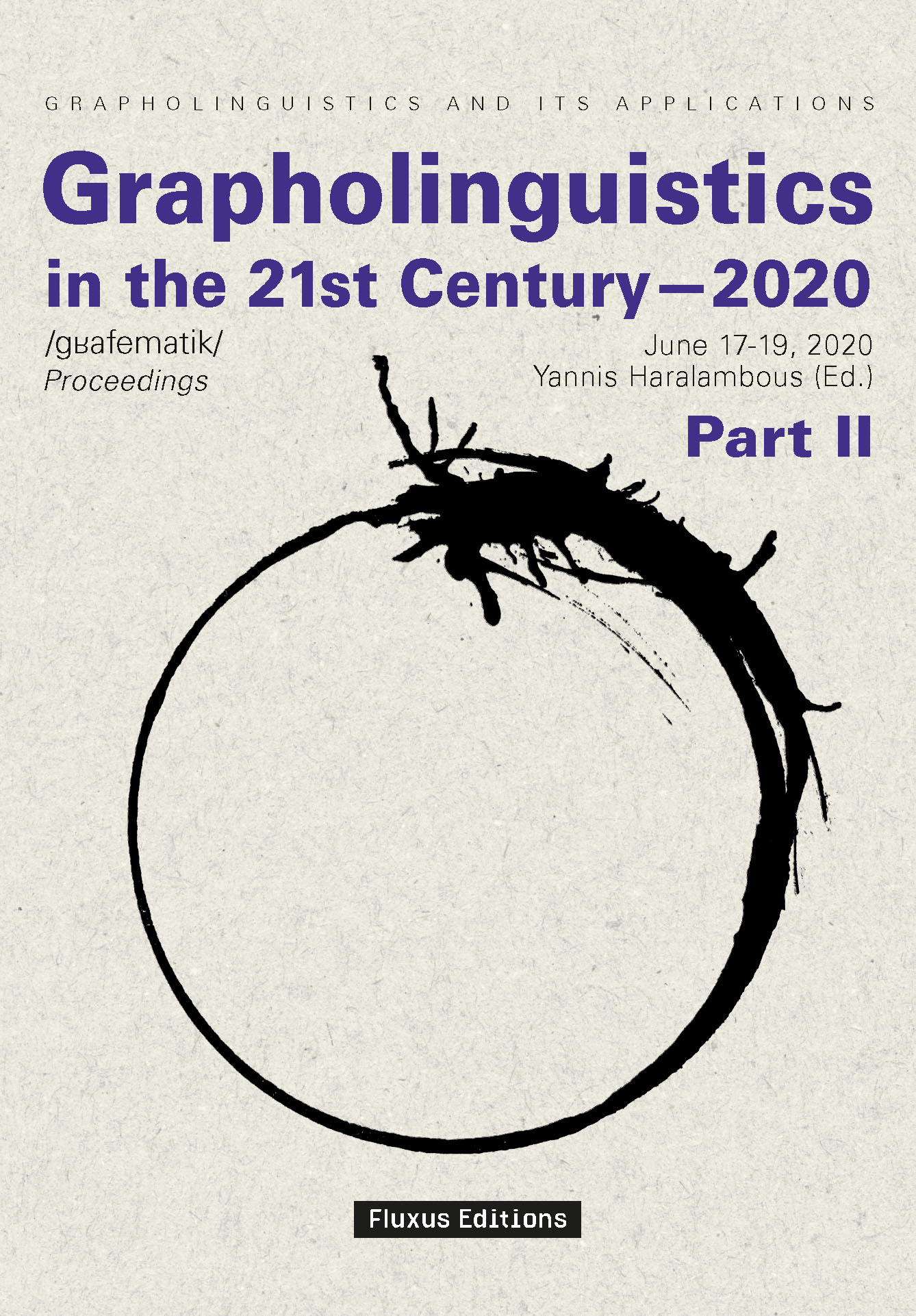
 ISSN: 2534-5192 (electronic) – 2681-8566 (print)
ISSN: 2534-5192 (electronic) – 2681-8566 (print)
 ISSN: 2534-5192 (electronic) – 2681-8566 (print)
ISSN: 2534-5192 (electronic) – 2681-8566 (print)| ◀ J. Myers | ▲ Proceedings | T. Stojanov ▶ |
 ISBN: 978-2-9570549-7-8 e-ISBN: 978-2-9570549-9-2  | Viewpoints on the Structural Description of Chinese Characters Tomohiko Morioka  Abstract. This paper is about our viewpoints and methodology concerning the description of the structure of Chinese characters. First, we describe how components can be detected in characters. When a character is used as a component of a compound character and its shape appears without significant change, then the component can be easily identified. However, in many cases, it is not so easy to find the components that build a character out of purely visual features. One of the factors is simplification of the graphic form when characters are assembled out of components. Such a change of glyph form reduces the connection with pronunciation and meaning of the original character and increases the symbolic aspect of the character. It is particularly complicated when multiple components are combined, transformed and demotivated into a symbolic component. Here we discuss these issues with respect to the productivity of components and to the relationships between components and characters. DOI: https://doi.org/10.36824/2020-graf-mori
@MISC{Asahara_jifu_1996,
AUTHOR = {Asahara, Tatsuro},
AUTHOR_ORIGINAL = {浅原達郎},
AUTHOR_ORIGINAL+AN = {1=ja-Jpan},
TITLE = {{\japanese 漢字の字符} [Chinese Character Graphemes]},
YEAR = {1996},
URL = {http://yuetgu.zinbun.kyoto-u.ac.jp:8098/yg/rs/jihu.pdf},
}
@MANUAL{UCS,
TITLE = {Information technology---Universal Coded Character Set (UCS)},
YEAR = {2014},
NOTE = {ISO/IEC 10646:2014},
}
@ARTICLE{CHISE-JJADH1,
AUTHOR = {Morioka, Tomohiko},
AUTHOR_ORIGINAL = {守岡知彦},
AUTHOR_ORIGINAL+AN = {1=ja-Jpan},
TITLE = {Multiple-policy Character Annotation based on {CHISE}},
JOURNAL = {Journal of the Japanese Association for Digital Humanities},
YEAR = {2015},
VOLUME = {1},
NUMBER = {1},
PAGES = {86--106},
}
@INPROCEEDINGS{CHISE-HNG-DADH2018,
AUTHOR = {Morioka, Tomohiko},
AUTHOR_ORIGINAL = {守岡知彦},
AUTHOR_ORIGINAL+AN = {1=ja-Jpan},
TITLE = {Integration of a Chinese Character Ontology Title and Historical Glyph Examples},
BOOKTITLE = {9th International Conference of Digital Archives and Digital Humanities (DADH 2018)},
YEAR = {2018},
PAGES = {287--300},
}
@ARTICLE{TRS-for-Unification-Rules-2018,
AUTHOR = {Morioka, Tomohiko},
AUTHOR_ORIGINAL = {守岡知彦},
AUTHOR_ORIGINAL+AN = {1=ja-Jpan},
TITLE = {{\japanese 項書き換え系を用いた漢字字体の包摂規準の形式化の試み} [An Attempt to Formalize Unification Rules of Chinese Characters Based on Term Rewriting System]},
JOURNAL = {{\japanese 情報処理学会論文誌} [Journal of the Information Processing Society of Japan]},
YEAR = {2018},
VOLUME = {59},
NUMBER = {2},
PAGES = {332--340},
}
@INPROCEEDINGS{gla1-slam,
AUTHOR = {Slaměníková, Tereza},
EDITOR = {Haralambous, Yannis},
TITLE = {{On the Nature of Unmotivated Components in Modern Chinese Characters}},
BOOKTITLE = {{Proceedings of Graphemics in the 21st Century, Brest 2018}},
PUBLISHER = {Fluxus Editions},
ADDRESS = {Brest},
YEAR = {2019},
PAGES = {209--226},
}
Tomohiko Morioka (2020), “Viewpoints on the Structural Description of Chinese Characters,” in Proceedings of Grapholinguistics in the 21st Century, 2020 (Yannis Haralambous, Ed.), Grapholinguistics and Its Applications, Vol. 5, Brest: Fluxus Editions, 683–712.
@INPROCEEDINGS{gla5-mori,
AUTHOR = {Tomohiko Morioka},
EDITOR = {Haralambous, Yannis},
TITLE = {{Viewpoints on the Structural Description of Chinese Characters}},
BOOKTITLE = {{Proceedings of Grapholinguistics in the 21st Century, 2020}},
SERIES = {{Grapholinguistics and Its Applications}},
VOLUME = {5},
PUBLISHER = {Fluxus Editions},
ADDRESS = {Brest},
YEAR = {2020},
PAGES = {683--712},
DOI = {https://doi.org/10.36824/2020-graf-mori},
}
|